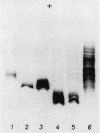Abstract
From a single cell fusion, five stable hybridomas secreting antiapolipoprotein E (apo E) were obtained. The immunoglobulin (Ig)G subclasses containing the respective monoclonal antibodies were isolated and were used as the antibody component in a solid-phase radioimmunoassay. The binding of 125I-apo E to the insolubilized antibody was inhibited by unlabeled apo E but not by unlabeled apoproteins A-I, A-II, C-II, and C-III, or by low density lipoprotein immunodepleted of endogenous apo E. Competition curves were obtained with lipoprotein subfractions that had the same shape as those obtained with purified apo E. Apo E levels in normal and hyperlipidemic plasma were well correlated when measured by the five monoclonal antibodies and polyclonal anti-apo E, although differences in absolute values were observed. In normal subjects 34, 10, 20, and 36% of apo E was recovered in the very low density lipoprotein, low density lipoprotein, high density lipoprotein, and the d greater than 1.21-gl/ml fractions, respectively, whereas these values were 34, 7, 12, and 47%, respectively, in type III patients. All antibodies indicated the same subfraction distribution of apo E. The monoclonal antibodies reacted with all of the isomorphs of apo E. One of the antibodies could be clearly distinguished by its reactivity with chemically modified very low density lipoprotein.
Full text
PDF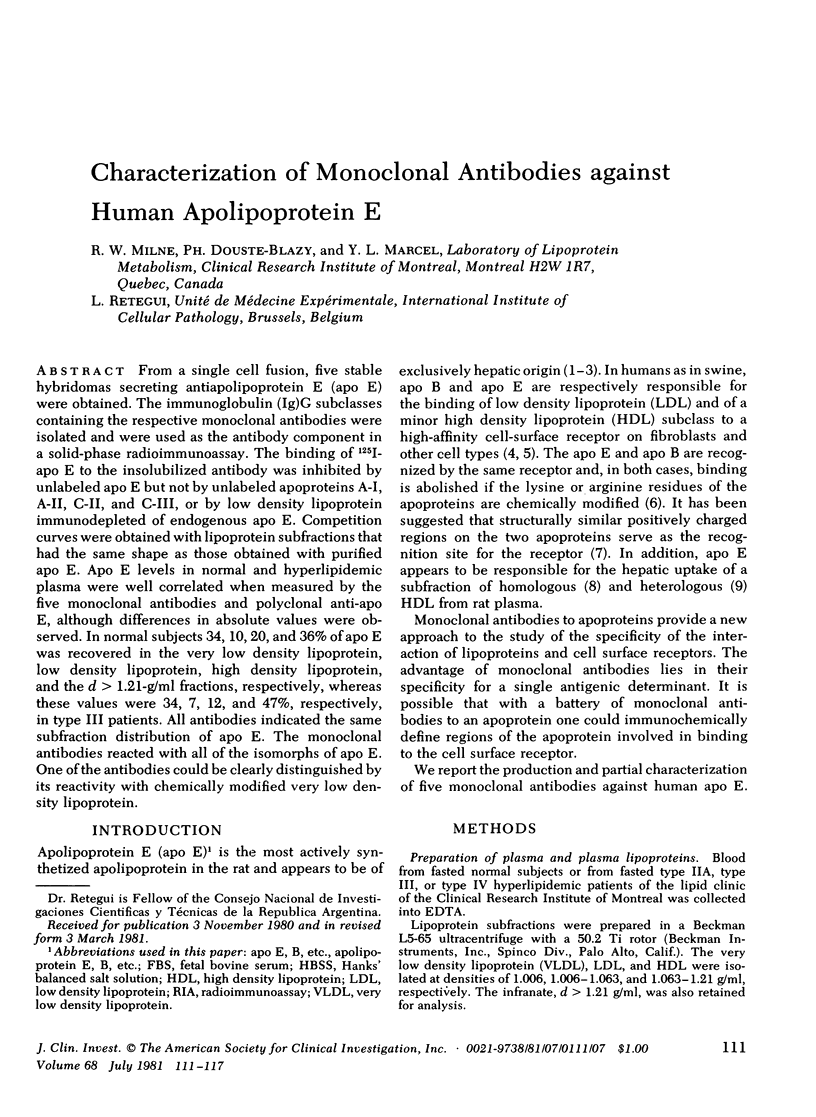
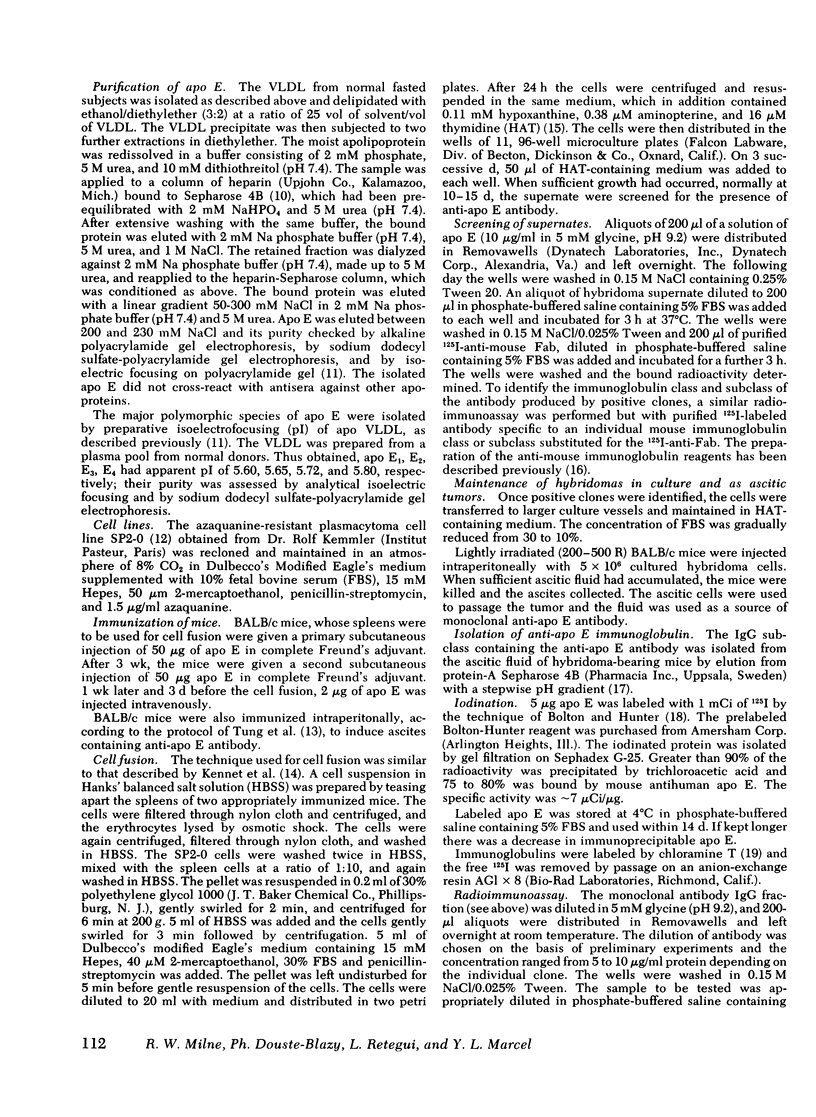
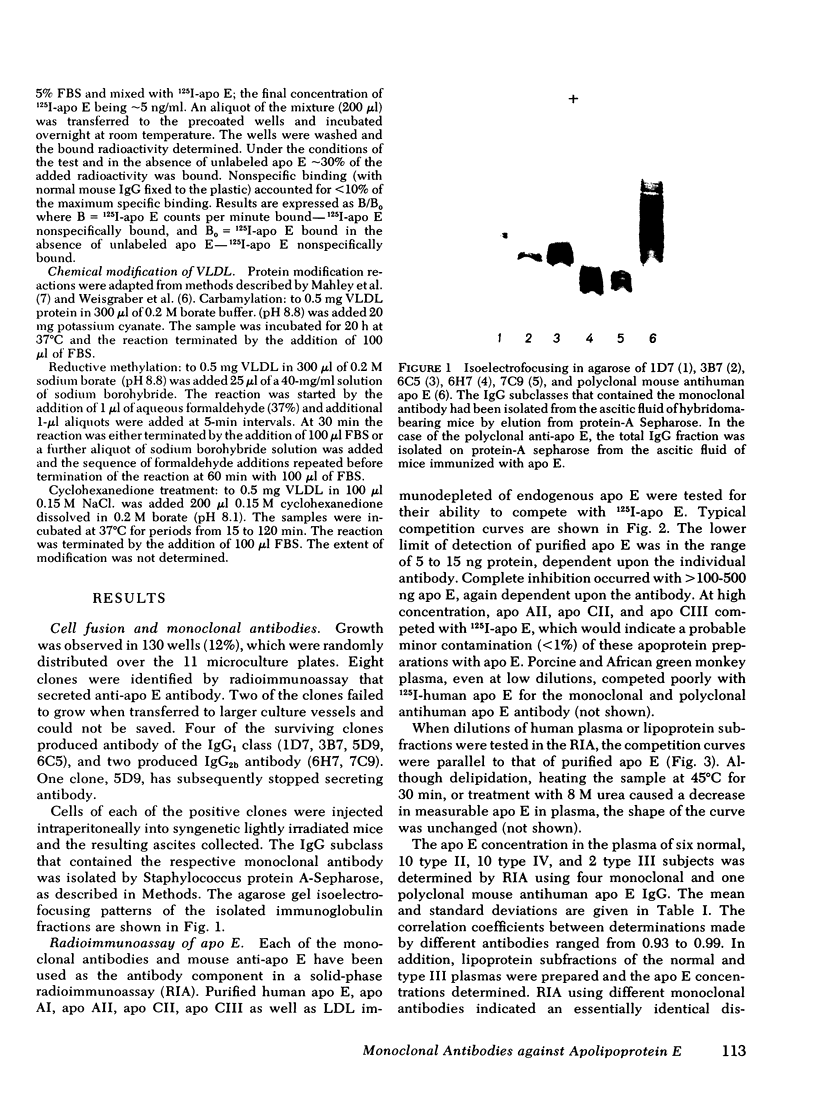
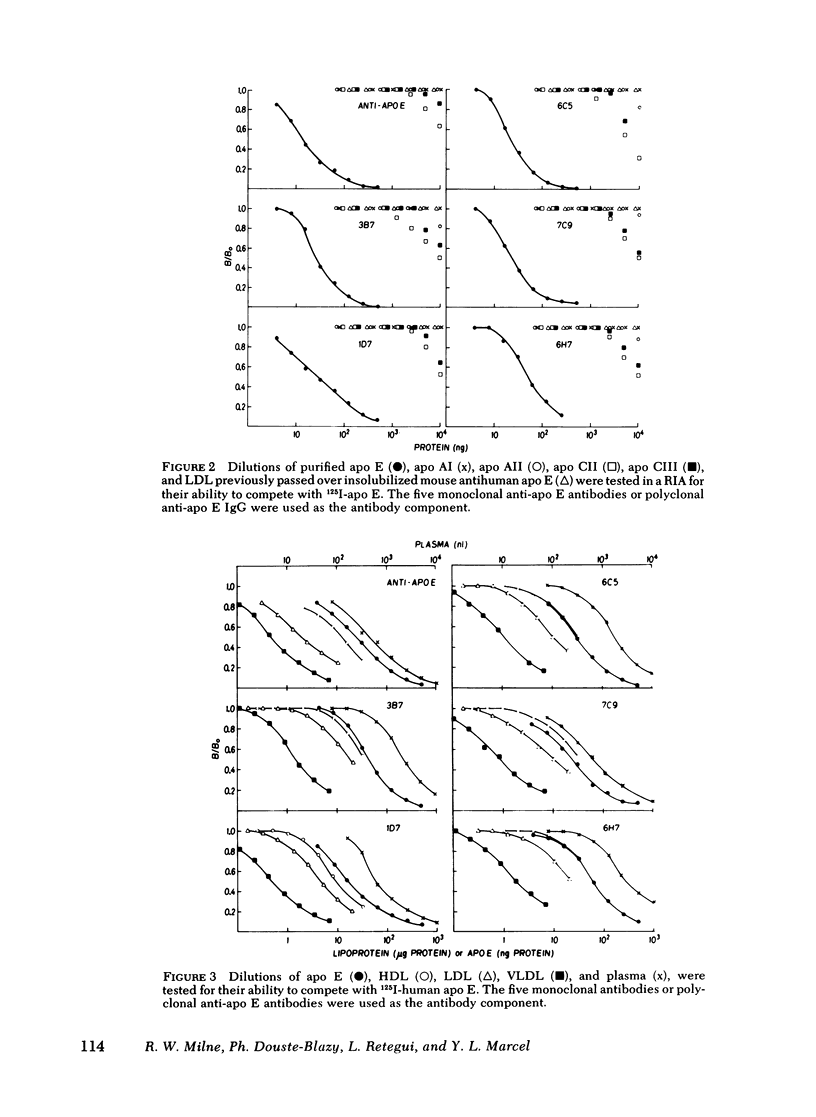
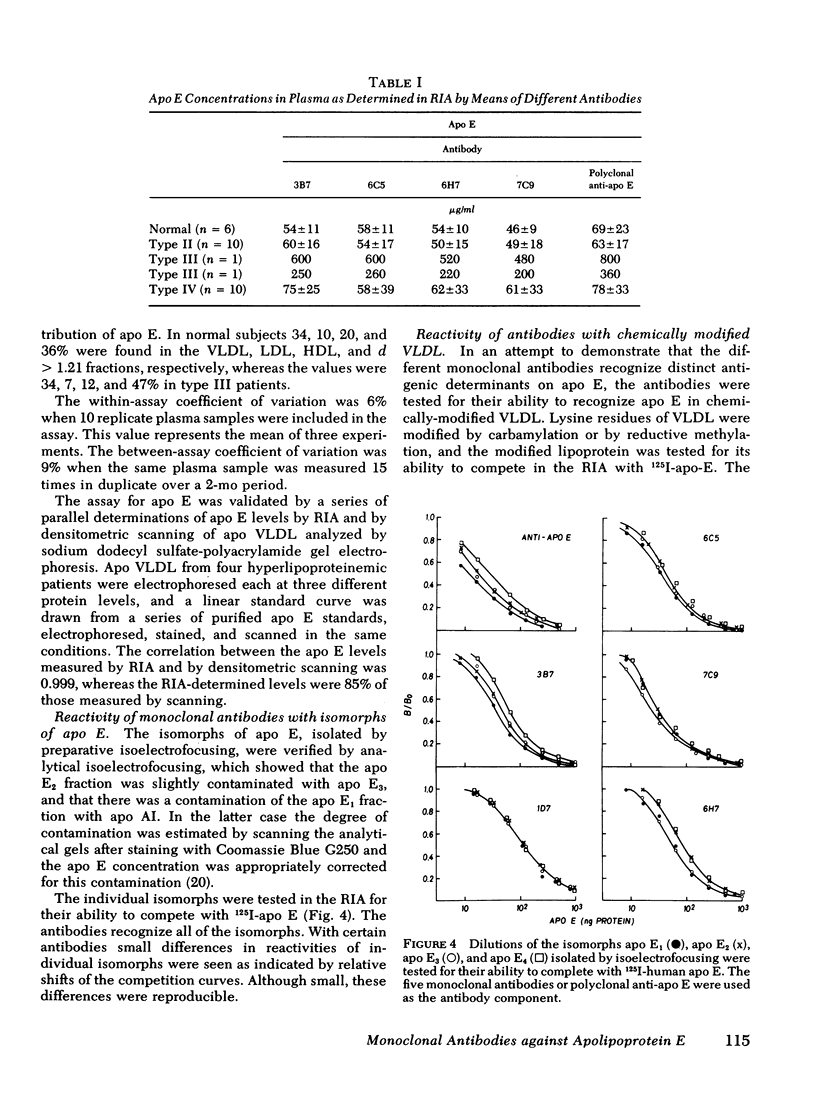
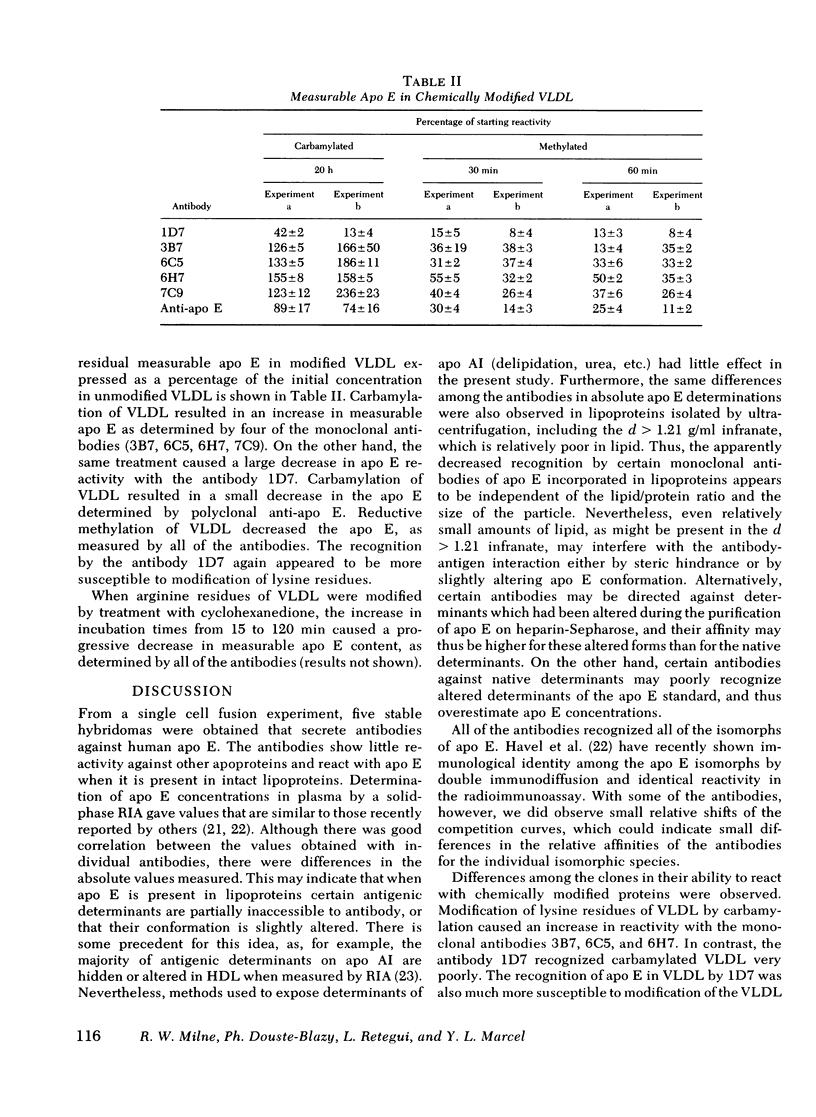
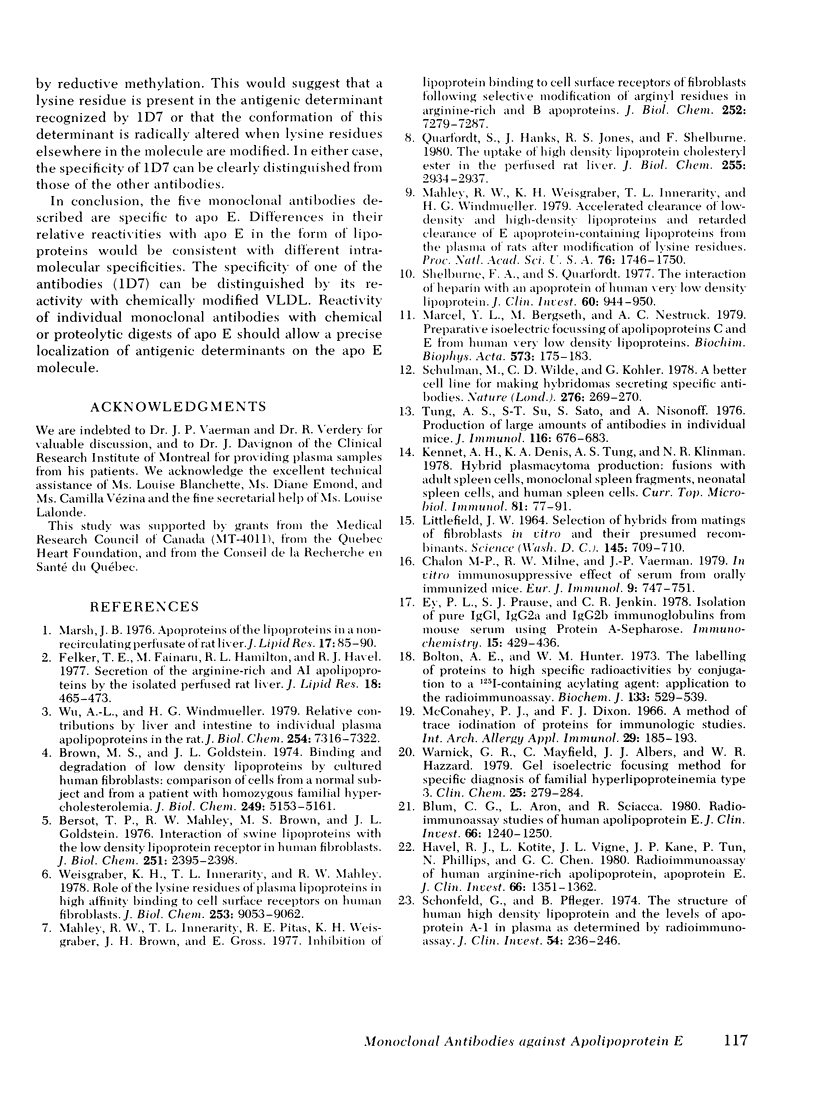
Images in this article
Selected References
These references are in PubMed. This may not be the complete list of references from this article.
- Bersot T. P., Mahley R. W., Brown M. S., Goldstein J. L. Interaction of swine lipoproteins with the low density lipoprotein receptor in human fibroblasts. J Biol Chem. 1976 Apr 25;251(8):2395–2398. [PubMed] [Google Scholar]
- Blum C. B., Aron L., Sciacca R. Radioimmunoassay studies of human apolipoprotein E. J Clin Invest. 1980 Dec;66(6):1240–1250. doi: 10.1172/JCI109975. [DOI] [PMC free article] [PubMed] [Google Scholar]
- Bolton A. E., Hunter W. M. The labelling of proteins to high specific radioactivities by conjugation to a 125I-containing acylating agent. Biochem J. 1973 Jul;133(3):529–539. doi: 10.1042/bj1330529. [DOI] [PMC free article] [PubMed] [Google Scholar]
- Chalon M. P., Milne R. W., Vaerman J. P. In vitro immunosuppressive effect of serum from orally immunized mice. Eur J Immunol. 1979 Oct;9(10):747–751. doi: 10.1002/eji.1830091002. [DOI] [PubMed] [Google Scholar]
- Ey P. L., Prowse S. J., Jenkin C. R. Isolation of pure IgG1, IgG2a and IgG2b immunoglobulins from mouse serum using protein A-sepharose. Immunochemistry. 1978 Jul;15(7):429–436. doi: 10.1016/0161-5890(78)90070-6. [DOI] [PubMed] [Google Scholar]
- Felker T. E., Fainaru M., Hamilton R. L., Havel R. J. Secretion of the arginine-rich and A-I apolipoproteins by the isolated perfused rat liver. J Lipid Res. 1977 Jul;18(4):465–473. [PubMed] [Google Scholar]
- Havel R. J., Kotite L., Vigne J. L., Kane J. P., Tun P., Phillips N., Chen G. C. Radioimmunoassay of human arginine-rich apolipoprotein, apoprotein E. Concentration in blood plasma and lipoproteins as affected by apoprotein E-3 deficiency. J Clin Invest. 1980 Dec;66(6):1351–1362. doi: 10.1172/JCI109988. [DOI] [PMC free article] [PubMed] [Google Scholar]
- Kennett R. H., Denis K. A., Tung A. S., Klinman N. R. Hybrid plasmacytoma production: fusions with adult spleen cells, monoclonal spleen fragments, neonatal spleen cells and human spleen cells. Curr Top Microbiol Immunol. 1978;81:77–91. doi: 10.1007/978-3-642-67448-8_13. [DOI] [PubMed] [Google Scholar]
- LITTLEFIELD J. W. SELECTION OF HYBRIDS FROM MATINGS OF FIBROBLASTS IN VITRO AND THEIR PRESUMED RECOMBINANTS. Science. 1964 Aug 14;145(3633):709–710. doi: 10.1126/science.145.3633.709. [DOI] [PubMed] [Google Scholar]
- Mahley R. W., Innerarity T. L., Pitas R. E., Weisgraber K. H., Brown J. H., Gross E. Inhibition of lipoprotein binding to cell surface receptors of fibroblasts following selective modification of arginyl residues in arginine-rich and B apoproteins. J Biol Chem. 1977 Oct 25;252(20):7279–7287. [PubMed] [Google Scholar]
- Marcel Y. L., Bergseth M., Nestruck A. C. Preparative isoelectric focussing of apolipoproteins C and E from human very low density lipoproteins. Biochim Biophys Acta. 1979 Apr 27;573(1):175–183. doi: 10.1016/0005-2760(79)90184-x. [DOI] [PubMed] [Google Scholar]
- Marsh J. B. Apoproteins of the lipoproteins in a nonrecirculating perfusate of rat liver. J Lipid Res. 1976 Jan;17(1):85–89. [PubMed] [Google Scholar]
- McConahey P. J., Dixon F. J. A method of trace iodination of proteins for immunologic studies. Int Arch Allergy Appl Immunol. 1966;29(2):185–189. doi: 10.1159/000229699. [DOI] [PubMed] [Google Scholar]
- Shulman M., Wilde C. D., Köhler G. A better cell line for making hybridomas secreting specific antibodies. Nature. 1978 Nov 16;276(5685):269–270. doi: 10.1038/276269a0. [DOI] [PubMed] [Google Scholar]
- Tung A. S., Ju S. T., Sato S., Nisonoff A. Production of large amounts of antibodies in individual mice. J Immunol. 1976 Mar;116(3):676–681. [PubMed] [Google Scholar]
- Warnick G. R., Mayfield C., Albers J. J., Hazzard W. R. Gel isoelectric focusing method for specific diagnosis of familial hyperlipoproteinemia type 3. Clin Chem. 1979 Feb;25(2):279–284. [PubMed] [Google Scholar]
- Weisgraber K. H., Innerarity T. L., Mahley R. W. Role of lysine residues of plasma lipoproteins in high affinity binding to cell surface receptors on human fibroblasts. J Biol Chem. 1978 Dec 25;253(24):9053–9062. [PubMed] [Google Scholar]
- Wu A. L., Windmueller H. G. Relative contributions by liver and intestine to individual plasma apolipoproteins in the rat. J Biol Chem. 1979 Aug 10;254(15):7316–7322. [PubMed] [Google Scholar]



